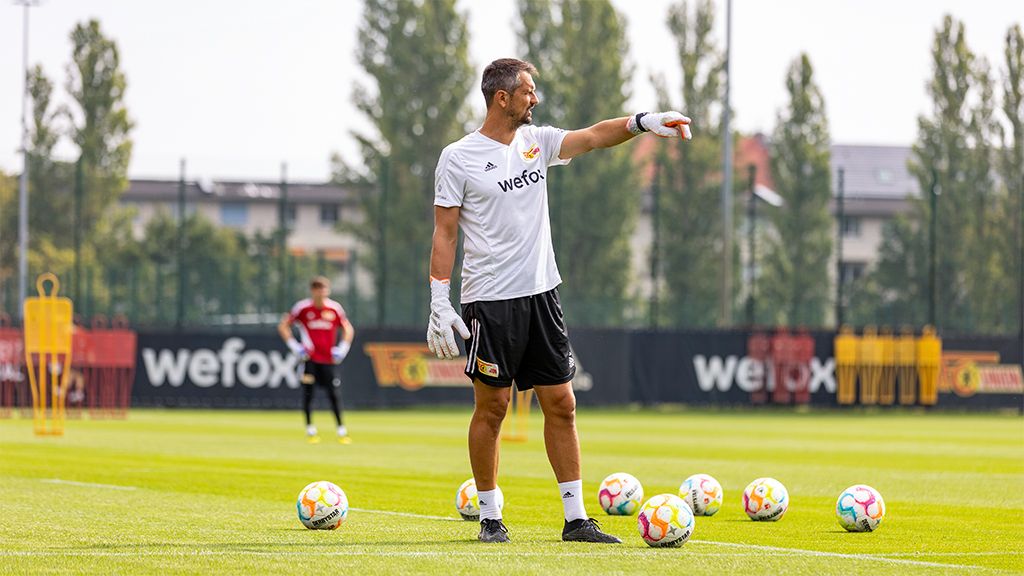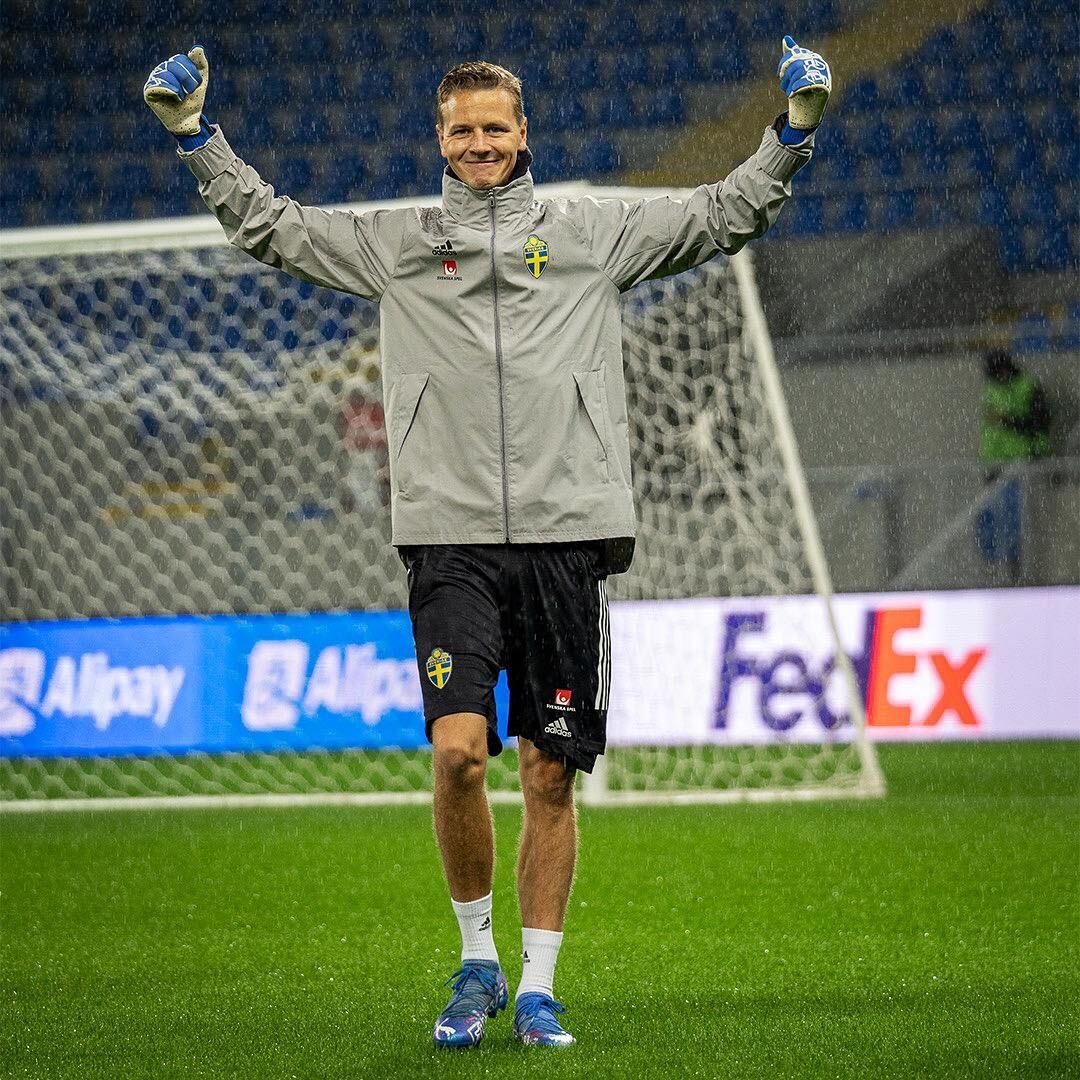Two of Europe's most respected goalkeeper coaches discuss how they plan a goalkeeper pre-season schedule.
Pre-season is a much less documented part of the football calendar. Welcome back videos will often be posted on the club’s social media, portraying a jovial ‘back-to-school’ atmosphere as everyone returns from their sun-soaked holidays. Hefty concentration is placed upon fitness as players recover from their well-deserved breaks, but what does the rest of the pre-season process involve for goalkeepers?
Michael Gspurning is Union Berlin’s Head of Goalkeeping and Goalkeeper Coach, playing an instrumental role in the club’s first-ever Bundesliga promotion in 2019 and Champions League qualification in 2023. These eye-catching achievements alerted Ralf Rangnick and the Austrian National Team to Gspurning’s talents, and he joined the side as the Goalkeeper Coach, alongside Union Berlin duties.
Gspurning is a firm believer that “preparation doesn’t begin with the first official training session, it starts during the off-season.” He places heightened importance on tracking and maintaining the goalkeeper’s condition.
“The players get time to recover mentally and physically,” Gspurning continued. “But they also receive individual programs to keep themselves in shape and address specific needs. It’s not just about aerobic running, it’s more about stabilising the body, correcting imbalances, and strengthening areas that are prone to overload. Ideally, they return feeling refreshed and more prepared than when they left.”
Gspurning says that “collaboration with other departments is a big priority” to monitor a goalkeeper’s fitness across the summer. He outlines that a “transdisciplinary approach,” involving various assistant coaches, each with a “specific area of expertise,” aids the process.
“For the summer break, the Head Athletic Coach defines the main program in exchange with the Individual Athletic Coach and my goalkeeper. After an exchange with the player, we implement possible additional exercises into their plan to give them self-responsibility.
“Before and during pre-season, we do a full strengths-and-weakness analysis, looking at injury history, physical screening, and technical tendencies.”
Gspurning articulates that it's of vital importance not to place goalkeepers under too much physical strain too quickly. “The adjustment to being on the pitch every day shouldn’t be underestimated,” he stressed. “Regularly, we start the pre-season with two days of conditioning drills, jumps and injury prevention tests.

“I pay close attention to their movement and how their bodies react. We do a lot of goalkeeper-specific movements, but at moderate intensity. Also lots of touches with the ball, but without overloading the joints or muscles. We spread the heavier loads carefully throughout the period.
“We’re in constant dialogue with the athletic and medical departments. We monitor with GPS data, and most importantly, we listen to the goalkeepers themselves with a questionnaire they fill out every morning before practice. If there are any signs of overload, we adjust immediately.”
Maths Elfvendal has been the Swedish National Team Goalkeeper Coach for nine years and was previously at Parma in Italy. The Swede recently joined Goalkeeper.com as Head of the organisation’s Advisory Board. He is an integral member of a group of experts aiming to ensure the thriving future of goalkeepers through inspiration, support and data.
Elfvendal emphasises principles of collaboration and creating player-specific programs when devising a pre-season training schedule. “I believe in creating an individual program in collaboration with the Strength and Conditioning (SoC) coach,” he said. “It's also important to involve the goalkeeper. This ensures that he truly understands the program and its significance. The SoC coach can motivate the exercises, while the Goalkeeper Coach should explain how these will help the goalkeeper improve.
“It's a delicate balance because you need to push the goalkeeper to improve certain physical aspects. That's why it's crucial to have a well-structured plan for the long, medium and short term. This ensures that the goalkeeper can both train intensively and recover in the best possible way within the schedule.”
The concept of a thoroughly planned and specifically tailored pre-season training schedule is crucial for both coaches. Elfvendal theorises these necessities through two concepts, the “Individual Development Plan” (IDP) and the “Periodisation of Specialised Training framework” (PoST)

“We start by looking at the environment in which our goalkeeper will play. This requires a deep understanding of the leagues or tournaments they will participate in, as well as how team tactics will affect the situations the goalkeeper faces. For example, if the team uses a high man-to-man defence, the goalkeeper might encounter more one-on-one situations.
“You should also include an analysis from the previous season, considering the team's and goalkeeper's performance, along with the IDP you have created, which is organised into different levels. I use the PoST to determine not just when, but also how to help the goalkeeper improve.”
Gspurning abides by a similar methodology, outlining a six-week pre-season plan with one or two training camps that he follows in Germany, focusing on regaining rhythm, adapting to the daily load and tactical integration.
"I structure the six-week pre-season with a clear periodisation: short-term, mid-term, and long-term priorities,” he said. “The goal is to have a group of keepers who are physically stable, tactically integrated, and mentally ready to lead when matchday one arrives. I don’t believe that pre-season needs to be about building a year’s worth of fitness in six weeks.
“In the first week, I focus on reintroducing goalkeeper movements and rebuilding rhythm. Even though the players follow individual programs during the break, nothing replaces the specific movements, footwork, and decisions we practice on the pitch. It's all about reactivation. That means a lot of lateral work, coordination and ball-handling exercises to get them feeling like goalkeepers again. They come back quickly to the used rhythm again, where we focus heavily on game-related situations.”
After this, Gspurning delves into the player-specific plans, creating an individual profile: “We assess where they are physically, technically, and mentally, and we define clear goals. This will be crucial for planning the periodisation and the training framework itself. There are always team principles, and the goalkeepers have to be aligned with those from day one.”
Gspurning splits his pre-season goalkeeper training schedule into three elements that support each other. Firstly, he focuses on the technical and tactical aspects. “I try to include all aspects of the goalkeeper game, technique, tactics, physical work, and communication. If team tactics shift, maybe because the head coach introduces new pressing triggers or defensive concepts, then I’ll adjust my drills.”
Secondly, he strengthens physical attributes by developing a “tailored athletic plan” for each goalkeeper. “We have a clear weekly structure: one day focused on lower body strength and core, one for upper body and shoulder stability, and one day for individual needs.”
Lastly, Gspurning also views pre-season as a fantastic opportunity to form a collaborative goalkeeping unit and grow personalities.
“We use this period to define roles within the group, strengthen leadership behaviours, and build trust with the defensive line. By the end of the six weeks, there’s a real sense of excitement. Everyone’s looking forward to that first match and being fully ready when it counts.
“What I really value is that ideas also flow both ways. Sometimes I notice something in training, maybe an issue with push-off speed or power in certain save patterns, and we discuss how we can support that physically. That kind of collaboration is crucial. It’s a big part of why we’ve had such a low injury rate and steady development in our physical performance markers over the years.”
Elfvendal explained the integration for new goalkeeper signings heading into pre-season. “You need the best possible understanding of the goalkeeper you are signing,” he underlined.
“You need to create an IDP that outlines how, when, and how often you should conduct individual sessions. The plan should also detail what ‘focus points’ should be included in the goalkeeper group sessions and what should be integrated with the team.”
Gspurning also detailed how he handles this process: “It’s important to engage with new goalkeepers as early as possible, ideally even during the off-season. I’ll usually send them a welcome video that includes our team principles, expectations, and also some positive clips from their previous matches to reinforce what they do well. That helps set the tone.
“Once they arrive, I sit down with them and with the whole group. I always ask: What have you done in the past? What worked well for you? Where do you want to develop? These conversations give me valuable input for planning and help build trust. Getting to know each other, creating a connection: that’s the foundation for everything that follows.”








